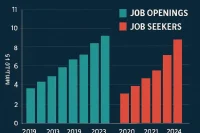Wells Fargo has recently terminated several employees for allegedly faking keyboard activity to appear productive.
The terminations, disclosed in broker filings with the Financial Industry Regulatory Authority (Finra), highlight the bank’s strict stance on unethical behavior.
The bank, America’s third largest, did not provide details on how the issue was discovered or if it was linked to remote work practices.
New regulations in the US now require home offices used by brokers be inspected every three years, potentially increasing scrutiny on remote work activities.
Wells Fargo spokeswoman Laurie Kight emphasized the company’s commitment to high standards and zero tolerance for unethical behavior.
Since the COVID-19 pandemic expanded remote work, many large companies have adopted sophisticated monitoring tools to track employee activity.
These tools can monitor keystrokes, eye movements, take screenshots, and log website visits.
In response, technology has also advanced to help employees evade such surveillance.
One popular device is the “mouse jiggler,” which makes a computer appear active.
Thousands of these devices, available for under $10 on Amazon, have been sold in recent months.
Wells Fargo’s filings indicate several employees resigned or were terminated after being found simulating keyboard activity to create the impression of active work.
According to Bloomberg, which first reported the firings, more than a dozen employees were affected.
The BBC confirmed six terminations and one voluntary resignation after employees were confronted with the allegations.
Many of those terminated had been with the company for less than five years.
This wave of terminations comes as many firms, particularly in the financial industry, push for a return to office work.
Need Career Advice? Get employment skills advice at all levels of your career
While remote work remains popular, its prevalence has decreased since the peak of the pandemic.
Recent research by professors at ITAM Business School, Stanford, and the University of Chicago indicates just under 27 percent of paid workdays in the US last month were remote.
Wells Fargo’s filings show employees left after they were found simulating keyboard activity to create the impression of active work
This is down from over 60 percent during the height of the pandemic in 2020.
As of this spring, about 13 percent of full-time US employees were fully remote, with another 26 percent in hybrid arrangements.
In 2022, Wells Fargo adopted a hybrid flexible model for most of its employees, reflecting the ongoing shift in work practices post-pandemic.




